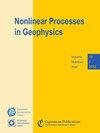推断流能、空间和时间尺度:自由漂移与定点观测
IF 2.4
4区 地球科学
Q3 GEOSCIENCES, MULTIDISCIPLINARY
引用次数: 0
摘要
摘要本文介绍了一种用于推断海洋变率时空分解的新方法,并对其在合成理想化配置中的性能进行了评估。该方法设计用于吸收速度观测数据。在推断海洋变率的时空尺度方面,对减少了的海面漂流器和锚系设备网络的能力进行了量化和对比。介绍了两类平台的推断性能对观测数量、几何配置和流态的敏感性。由于能同时对空间和时间变化进行采样,漂流器即使在单独部署时也能捕捉到空间和时间流动特性。系泊设备尤其适用于描述水流的时间变异性,而且还可以捕捉空间尺度,但前提是它们必须成倍增加,并且可以假设相关部署的财务和环境成本。我们特别指出,该方法能正确识别漂流器是否优先对空间和时间变化进行取样。这种方法为分析现有数据集以及设计未来以描述小尺度(例如 100 公里)海洋变化为目标的实验活动开辟了新途径。本文章由计算机程序翻译,如有差异,请以英文原文为准。
Inferring flow energy, space and time scales: freely-drifting vs fixed point observations
Abstract. A novel method for the inference of spatiotemporal decomposition of oceanic variability is presented and its performance assessed in a synthetic idealized configuration. The method is designed here to ingest velocity observation. The abilities of networks of reduced number of surface drifters and moorings at inferring spatiotemporal scales of ocean variability are quantified and contrasted. The sensitivities of inference performances for both types of platforms to the number of observation, geometrical configurations, flow regimes are presented. Because they simultaneously sample spatial and temporal variability, drifters are shown to be able to capture both spatial and temporal flow properties even when deployed in isolation. Moorings are particularly adequate for the characterization of the flow temporal variability, and may also capture spatial scales provided they are multiplied and the financial and environmental costs of associated deployments can be assumed. We show in particular that the method correctly identifies whether drifters are sampling preferentially spatial vs temporal variability. This method opens novel avenues for the analysis of existing datasets as well as the design of future experimental campaigns targeting the characterization of small scale (e.g. <100 km) Ocean variability.
求助全文
通过发布文献求助,成功后即可免费获取论文全文。
去求助
来源期刊

Nonlinear Processes in Geophysics
地学-地球化学与地球物理
CiteScore
4.00
自引率
0.00%
发文量
21
审稿时长
6-12 weeks
期刊介绍:
Nonlinear Processes in Geophysics (NPG) is an international, inter-/trans-disciplinary, non-profit journal devoted to breaking the deadlocks often faced by standard approaches in Earth and space sciences. It therefore solicits disruptive and innovative concepts and methodologies, as well as original applications of these to address the ubiquitous complexity in geoscience systems, and in interacting social and biological systems. Such systems are nonlinear, with responses strongly non-proportional to perturbations, and show an associated extreme variability across scales.
 求助内容:
求助内容: 应助结果提醒方式:
应助结果提醒方式:


